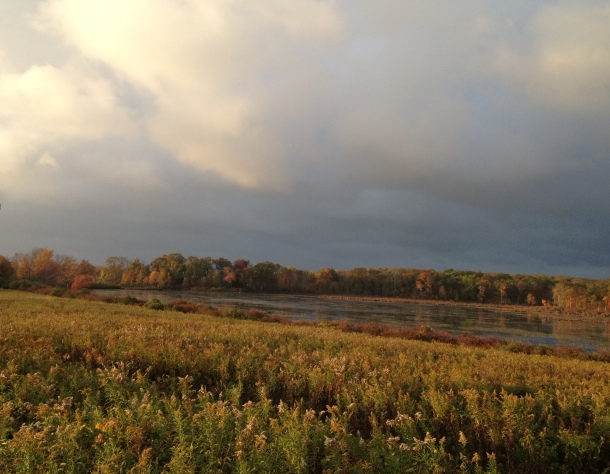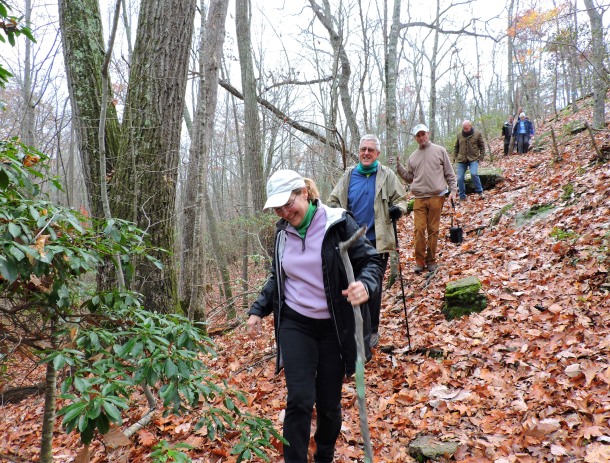This is the fifth post in our A Time to Be Grateful series. See all the posts here.
There are few things more fundamental to human life than pure drinking water. A decade-and-a-half ago, CFE co-founded a coalition to protect threatened lands that filter our drinking water supply. Little did we know then how much that fight would shape the future of Connecticut’s land protection laws—and the very way we work.
Today, there’s a new threat to drinking water lands. As we join with new and longtime allies to fight this latest battle, we’re thinking with gratitude of the many partners who band together to defend our precious forests, wetlands, shorelines, and mountains.

That first big coalition was the Endangered Lands Coalition, founded in 2001 to save over 15,000 acres owned by the Kelda water company. Before that battle, CFE had operated largely as a nonprofit environmental law firm—taking on tough cases, but not yet mobilizing large numbers of citizens for political efforts. With the backing of 200 coalition members, we were able to save the Kelda lands and help get passed new laws to protect drinking water lands—some of the strongest in the nation.
Now, a power company from Tennessee wants to build a gas pipeline that would cross protected lands west of Hartford. The proposed pipeline route, which would be hundreds of miles in length over five states, would directly affect 5.7 miles of land belonging to the Metropolitan District Commission, in addition to other Connecticut lands. The MDC parcel includes both drinking water reservoirs and beloved nature trails. As soon as they learned of the threat, veterans of past land battles—like Rivers Alliance, CT Forest & Park Association, Connecticut Land Conservation Council, and Sierra—and new allies like Food & Water Watch (and more!) sprang into action to defend the parcel. At noon today, we filed an intervention in the power company’s federal application. We hope other allies will also do so. That move will give us more power to affect the outcome while we continue to work with the landowners whose property would be affected and build a strong statewide network of objectors.

It’s not just water companies that own lots of land in Connecticut—electric utilities do, too. When Northeast Utilities merged with NSTAR in 2012, we intervened to make sure that the 9,500 acres NU owned—including beloved sites like Skiff Mountain in Sharon and Maromas in Middletown—would remain as open space. Citizens across Connecticut spoke loudly—the agency in charge of the merger said they were swamped with messages from the public urging protection for the NU lands. And it worked! A protection clause was written into the merger agreement for several of the most ecologically and recreationally valuable properties, and a new land trust set up to protect them.
But land fights don’t always spring from big utility mergers. Often, there’s a very simple cause: developers want to build houses in spots with a lot of natural beauty. Understandable! Problem is, the beautiful places often get destroyed in the process…or privatized so only a few people can enjoy them. These land fights can stretch over years and years, so an alliance of multiple organizations and committed local residents is critical to keeping the momentum going.

That’s what has been happening in East Lyme for more than a decade. A developer wants to build 840 units of housing and 1,767 parking spaces on a steep, rocky piece of land that abuts the Oswegatchie Hills Nature Preserve and drains to the fragile Niantic River. Two dedicated local groups, the Friends of the Oswegatchie Hills Nature Preserve and Save the River – Save the Hills, have been fighting for years to stop this inappropriate and environmentally harmful development. CFE joined them this summer, linking our legal expertise and state-wide reach to STR-STH’s and the Friends’ deep knowledge and vibrant local networks.
Just across the Sound from East Lyme is another beautiful spot at risk. At 840 acres, Plum Island is far from the biggest parcel we’ve worked to defend, but it may be the biggest fight yet—we’re taking on the Department of Homeland Security, the General Services Administration (the federal government’s real estate agent), and major developers like Donald Trump. A big fight needs a big army. Fortunately, we’ve got one: the Preserve Plum Island Coalition, a group of over 60 Long Island, Connecticut, New York, and national organizations. The coalition is led by CFE/Save the Sound, Audubon CT and NY, Citizens Campaign for the Environment, Group for the East End, Louise Harrison, Huntington-Oyster Bay Audubon Society, North Fork Environmental Council, and The Nature Conservancy. Each group brings its own specialties, from federal lobbying to law to wildlife protection to local politics. And elected officials are playing an invaluable role, with U.S. senators and representatives from both New York and Connecticut introducing legislation to stop the sale. New York state and county legislators, and officials in the Town of Southold are doing their part to protect the island through zoning and by appealing to Governor Cuomo. Their leadership has been invaluable. Together we’re working on a multiplicity of fronts to stop an auction of this historic, habitat-rich island and make sure it is conserved.
As that battle stretches on, we take heart from the victory in one of Connecticut’s most important land protection efforts of recent years.

The Preserve, a 1,000-acre parcel of coastal forest and wetlands, was finally permanently conserved in 2014 after two decades of fighting in the courts, local commissions, and public opinion. The effective partnership unpinning the effort to save The Preserve has become a model for land battles in Connecticut. It’s impossible to list everyone who made the victory possible. Residents of Old Saybrook, Essex, and Westbrook first formed the Alliance for Sound-area Planning, which led the local grassroots effort years, mobilizing citizens to turn out at hearings and vote for local bonding money. CFE entered the fray with our attorneys to make the case in wetlands and zoning hearings, and eventually in courtrooms. Phil Miller started as first selectman of Essex and took the fight with him when he was elected state representative, helping build support in Hartford. Governor Malloy and CT DEEP got behind the effort. And the Trust for Public Land stepped in with their land acquisition expertise to hammer out a deal and raise the private funds necessary to purchase the property. And at long last, this summer, the ribbon was cut to open The Preserve as a permanently conserved property.

It was a long, long effort, but a shining illustration of how strong coalitions can make incredible things happen. We’re grateful to all our partners who dedicate their blood, sweat, and tears to saving these irreplaceable places.




1 thought on “A Time to Be Grateful: Conserving Lands Together”
Comments are closed.